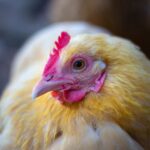All educational & Resource Articles Are Submitted By Volunteers
The Easter Egger, also known as Rainbow Layers and a few other names, is a beloved hybrid chicken among backyard poultry enthusiasts. This breed comes in two sizes, a smaller “bantam” size and a larger, “standard” size.
Easter Eggers don’t have a clear-cut history regarding their breeding and development. However, it’s commonly believed that they are typically a cross between Ameraucanas and Araucanas, though they can be mixed with almost any breed as long as they produce colored eggs. While Easter Eggers may resemble pure Ameraucanas, they are quite different; true Ameraucanas only lay blue eggs. Unfortunately, hatcheries and farm stores often purposely mislabel Easter Eggers as “Americanas” or “Ameraucanas,” either to make them more appealing for sale or due to confusion, which can mislead new buyers on what they’re actually purchasing.
Easter Eggers are incredibly popular, largely due to the delightful surprise of not knowing what egg color they’ll produce. As their nickname “rainbow layers” suggests, they can lay eggs with shells in a wide array of colors. This unique trait makes them a favorite among both novice and experienced flock owners, who love their vibrant and unpredictable egg and feather colors and patterns. Easter Eggers are wonderfully unique, with no two looking exactly alike—similar to human fingerprints. Some may have muffs and beards, while others do not, and their plumage patterns and colors are highly varied, making each bird distinct. They are hardy chickens, able to withstand both cold and warm climates with ease. While some Easter Eggers may have ear tufts, others may not, but a common distinguishing feature is their greenish or yellowish leg color.
Quick Breed Facts
- Alternative name(s): EE, Americana, Rainbow Egger
- Hen (female) weight: Standard – 4lbs / bantam – 1.5lbs
- Rooster (male) weight: Standard – 5lbs / bantam – 2lbs
- Eggs per-week: 3-4
- Egg productivity: Good
- Egg color: Blue, shades of green & sometimes brown
- Egg size: Standard – large / bantam – small
- Category / purpose / use: Eggs
- Temperament: Needy, docile, flighty, loud, friendly
- Broodiness: Rarely
- Comb type: Pea
- Rarity: Common
- Feathered legs: No
- Breed size: Standard & bantam
- Climate tolerance: All climates
- Foraging (free-ranging) ability: Excellent
- Hybrid: Yes
- Skin color: Yellowish, greenish & sometimes pink
- Other color varieties: Olive Egger
- Recognized in the American Poultry Association?: No
- Country of origin: USA
Frequently Asked Questions
Is this breed a good beginner-type breed?: Yes, Easter Eggers make a great addition to any mixed flock and are wonderful family pets! They are easy to raise and do well in any kind of flock. Depending on their genetics, some Easter Eggers may be more jumpy and flighty, while others may be friendly, curious, and docile. Easter Egger pullets typically start laying around 16 to 18 weeks of age, although this can vary with each bird.
Can this breed do well in a confinement-like setting?: Easter Eggers can handle confinement fairly well, as long as they have plenty of activities to keep them engaged. If bored, they may start picking on each other or bullying younger flock members. Being somewhat needy and occasionally flighty, they thrive when given something to occupy their time. The ideal setup for Easter Eggers is to allow them to free-range, where they can stretch their wings, run around, and forage for insects.
Is this breed predisposed or prone to any health conditions, concerns or disease?: Easter Eggers are sensitive during incubation, and even minor temperature fluctuations or poor genetics can lead to permanent hatching defects, such as crossbeak or splayed legs. These chickens are also prone to vitamin deficiencies if they don’t receive a proper, balanced diet. To support their health, make sure that they have the right nutrition and consider adding vitamins to their feed or water source to prevent deficiencies from occurring. Since being bred strictly for egg production, this breed has an increased risk of becoming egg bound and having a shorter lifespan compared to other breeds of chickens.
How does this breed handle different climates & temperatures?: Easter Eggers are well-suited to a variety of climates. Their pea combs and minimal wattles make them less prone to frostbite in a colder climate. In warmer climates, their lighter feathering helps them handle the heat more effectively, making them a hardy choice year-round.


The Pros & Cons of Easter Egger Chickens
The pros:
- They make a wonderful beginner breed of chicken for newbie chicken owners!
- They’ll lay a variety of colored eggs, including blue, different shades of green and sometimes brown!
- Wonderful foragers, performing great with a free-range setting.
- Roosters of this breed are a lot more tolerant of each other and are less likely to fight as long as there is enough room to get away.
- They are a breed that can be found almost anywhere!
- Each Easter Egger boasts its own unique plumage, pattern, and a stunning array of color variations, making no two Easter Eggers look alike!
- Easter Eggers are vary birds and go great in all types of climates!
- They have a much lower chance of developing frostbite due to their small, pea-sized combs and minimal wattles.
- Easter Eggers are not typically known for going broody, which helps maintain a steady egg production.
The cons:
- Depending on their genetics, some Easter Eggers may be friendlier than others. They are also an active breed, which can make them naturally jumpy and flighty if not properly socialized at a younger age.
- Although Easter Eggers can tolerate confinement, they can become easily bored and start picking on other flock members.
- Easter Eggers have a higher chance of hatching with crossbeak or splay-legged, which can be caused by poor genetics or improper incubation conditions.
- Easter Eggers are one of the chicken breeds that may require a vitamin boost on occasion, as they are prone to vitamin deficiencies.
- Since this breed was bred strictly for egg production, Easter Egger chickens have an increased risk of becoming egg-bound (egg binding / egg that is stuck inside), Salpingitis (lash egg infection caused by the Staph bacteria), developing reproductive cancer, and having a shortened lifespan.
Are Easter Eggers the right breed of chicken for you?
Yes— the Easter Egger chicken breed is good for you or your flock if you..
- Want an excellent egg layer of blue-colored eggs.
- A breed of chicken that can perform well and is tolerant of all climates.
- Want a breed that’s hardy and easy to raise.
- Want a uniquely-colored chicken added to your flock!
- Are looking for a breed of chicken that are wonderful foragers and performs very well in a free-ranging setting.

Photos/pictures provided by Google
If you own any of the photos above and wish to have them removed, please email the rescue’s email.
Chicken Chicken breeds Chickens Easter Egger Easter Eggers Rainbow Eggers
Last modified: December 8, 2024









